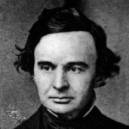Going Out on a Limb to Stop a Fast-Growing Crime: Modern Slavery
Miller McKim would never forget the day that a Richmond shoemaker named Samuel Smith showed up at his Philadelphia office with a most improbable proposal. He wanted to ship a human being–a slave named Henry Brown–from Richmond to Philly. Henry Brown hoped to escape by becoming a living parcel.
McKim initially agreed to accept the box at the office of the Pennsylvania Anti-Slavery Society, where he served as one of the group’s leaders. But the more he thought about it, the more convinced he became that Henry Brown would not survive the grueling journey by wagon, train, and steamboat. He was sure that Brown would reach Philadelphia dead on arrival, and the Anti-Slavery Society would be mired in scandal.
So McKim did what many of us might have done. He tried to back out.
But Samuel Smith wouldn’t let him. Smith, the Richmond shoemaker, insisted that he was going to ship the box with Henry inside, whether McKim liked it or not.
McKim, one of the most prominent abolitionist leaders in the 19th Century, faced an important choice. How far out on a limb should he dare to go? His fears were entirely reasonable, but he found himself dealing with a shoemaker who had a knack for going out on a limb–sometimes too far out on a limb. Smith was a gambler who had lost his home and family to his reckless risk-taking in the lotteries.
Like McKim, all of us must decide how far out on a limb we are willing to go in the service of others. This past weekend, I had the honor of spending time with two different groups of risk-takers. Last Saturday, I told Henry Brown’s story and spoke about human trafficking before the Prison Ministry group at Willow Creek Church in the Chicago suburb of South Barrington. Then on Sunday I went to a screening of Call and Response, a powerful documentary about modern slavery sponsored by an anti-trafficking group in Champaign.
Consider the statistics:
An estimated 27 million people are in bondage to slavery worldwide at this moment. What’s more, according to the U.S. State Department, about 14,500 to 17,500 people are trafficked into the United States each year. After drug dealing and arms dealing, trafficking of humans is the third largest criminal industry in the world, for its profits are enormous. In Henry Brown’s day and age, a slave would have cost (in modern money) $40,000. Human traffickers today buy and sell people for a few hundred dollars.
In America, today’s slaves are invisible, many of them forced into the sex trade or into more ordinary jobs, such as domestic work. Maria was one such person. This 12-year-old girl was enticed to Laredo, Texas, with the promise of an education and a good job as a domestic servant. When the police found her, she was chained in the backyard, barely fed, and hidden from view by an 8-foot concrete wall.
What we need are today’s Miller McKims and Samuel Smiths. Risk takers. People who are willing to go out on the limb. What we need are abolitionists.
By Doug Peterson

